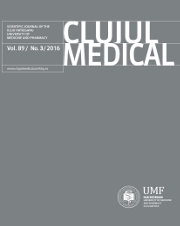Depression in Romanian patients with type 2 diabetes: prevalence and risk factors
DOI:
https://doi.org/10.15386/cjmed-641Keywords:
type 2 diabetes, depression, diabetes distressAbstract
Background and aims. Co-existing major depression was found to have a negative impact on the diabetes outcome and the quality of life. The aim of the present study was to assess the prevalence of depressive symptoms in Romanian diabetes patients and to identify the risk factors associated with depression.
Methods. A total of 144 type 2 diabetes patients were included in the study. Five models of presumed predictors were used to assess the risk factors for depressive symptoms, using hierarchical regression analysis. Together with demographics, disease, lifestyle predictors, previous depressive symptoms and diabetes distress were taken into account.
Results. In our sample the prevalence of depression was 12.6%. Main risk factors for depressive symptoms were previous depressive symptoms which were associated with depression in both Model 4 (β=0.297, p=0.013) and Model 5 (β=0.239, p=0.017) and diabetes distress in Model 5 (β=0.540, p≤0.001). Employment (β =-0.276, p=0.029) and increased number of diabetes complications (β=0.236, p=0.017) became significant when diabetes distress was added to the analysis.
Conclusions. The overall prevalence of depressive symptoms was found to be in range with the prevalence identified in the literature. Previous depression and diabetes distress were both independently associated with depression, confirming the bidirectional relationship between depression and diabetes distress. Due to the consequences for daily living, screening for diabetes distress and depression should be done in primary care units both by physicians and trained nurses.
Downloads
Additional Files
Published
How to Cite
Issue
Section
License
The authors are required to transfer the copyright of the published paper to the journal. This is done by agreeing to sign the Copyright Assignment Form. Whenever the case, authors are also required to send permissions to reproduce material (such as illustrations) from the copyright holder.

The papers published in the journal are licensed under a Creative Commons Attribution-NonCommercial-NoDerivatives 4.0 International License.

